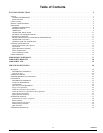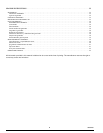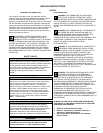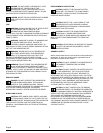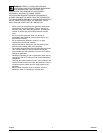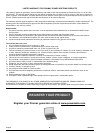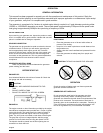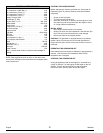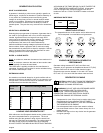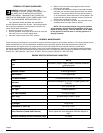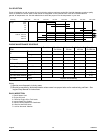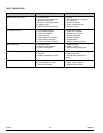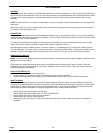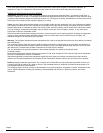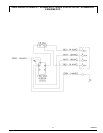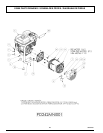
0069439
11
English
GENERATOR APPLICATION
WHAT IS A GENERATOR
A generator is basically a prime mover, typically a gasoline or
diesel engine, coupled to an alternator to produce electricity. It
is very useful as a substitute power source during power
outages or as the primary source in remote locations where
power is not available. Generators are essential for people
such as contractors or farmers who are always in need of
portable power. They are also very convenient for recreational
use.
SELECTING A GENERATOR
Selecting the proper generator is important. A generator that is
too small for your application will not run all of the equipment
needed. A generator that is too large will cost more and if
never used to its potential the money is wasted. The correct
size generator is determined by totaling the wattage
requirements of the items to be used simultaneously,
determine additional starting wattage requirements and total
these numbers. Select a generator with a continuous rating
that exceeds this by about 20% to allow for expansion. See the
table in the section titled “Generator Set Overload” for some
wattage guidelines of common equipment.
RATED vs. SURGE WATTS
Rated
, or continuous, watts are the watts an item needs as it is
running.
Surge
, or maximum, watts are the watts an item needs to start.
This is typically 2-4 times the rated watts.
This information is typically provided on the manufacturer’s
nameplate. If watts are not provided, it can be calculated using
the formula: Watts=Amps x Volts.
EXTENSION CORDS
An extension cord should always be in good condition with no
damage to the wires or sheathing. Never run an extension cord
through water. The correct wire size for an extension cord can
be determined from the table that follows.
LOADING YOUR GENERATOR SET
With reference to the Receptacle details section, please review
the power receptacles fitted to your generator. The circuit
breaker rating and the generator rating drive the actual load
that may be pulled from each receptacle. The ratings shown in
the table are the maximum available from each receptacle.
DO NOT EXCEED THE INDIVIDUAL RECEPTACLE RATINGS
AS SHOWN IN THE TABLE BELOW. DO NOT EXCEED THE
TOTAL GENERATOR NAMEPLATE RATING. All generator
units are equipped with a thermal-magnetic main circuit
breaker as well as a "PUSH TO RESET" breaker on branch
circuits.
AMPERAGE RATE TABLE
ENGINE LIMITATIONS ON GENERATOR
PERFORMANCE
Generator ratings assume 60°F (20C) and Sea Level.
Operation of your generator at temperatures above 60°F (20C)
or above Sea Level will result in lower electrical output.
Electrical output must be derated 1% for each 10°F above
60°F and 3 ½ % for each 1000 feet above mean sea level.
GENERATOR CLEANING
CAUTION: ALWAYS SHUT DOWN THE GENERATOR
AND ALLOW IT TO COOL COMPLETELY BEFORE
PERFORMING CLEANING OPERATIONS.
WARNING: DO NOT USE HIGH PRESSURE WATER
OR A GARDEN HOSE TO CLEAN YOUR
GENERATOR. WATER INTRODUCED INTO THE
GENERATOR CAN CAUSE ELECTRICAL SHORTS,
GENERATOR DAMAGE OR PERSONAL INJURY.
• Compressed air (max. 25 psi) may be used to blow loose
dirt and dust from your generator. DO NOT DIRECT
COMPRESSED AIR DIRECTLY INTO ANY OPENING IN
THE GENERATOR OR ENGINE.
• Use a dampened cloth to wipe clean exterior surfaces.
• Use a soft bristle brush to clean/ loosen heavy dirt, oil or
grease deposits.
• NEVER insert rags, tools or any device into the generator
or engine openings.
Model
NEMA
5-20R
125V GFCI
S2800 20 Amps
Continuous
Load
Minimum Cord Gauge (AWG)
Amps 0-50 Feet 50-100 Feet 100-150
Feet
20
25
30
35
40
50
12
12
10
10
8
6
10
10
8
8
6
4
8
6
6
4
2
2
RECEPTACLE DETAILS
The receptacles shown in this section are for reference only.
Each receptacle is not available on all generators.



